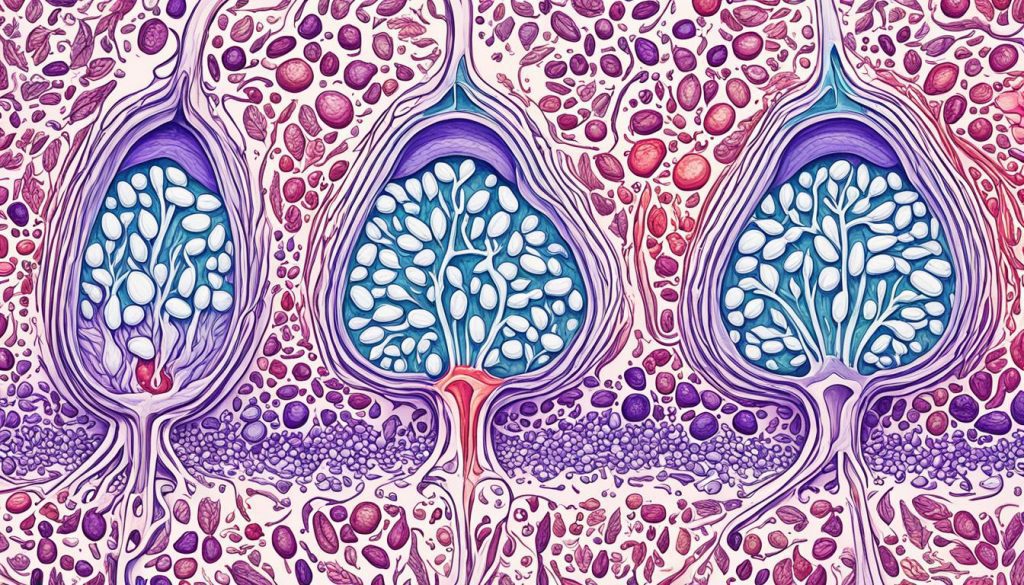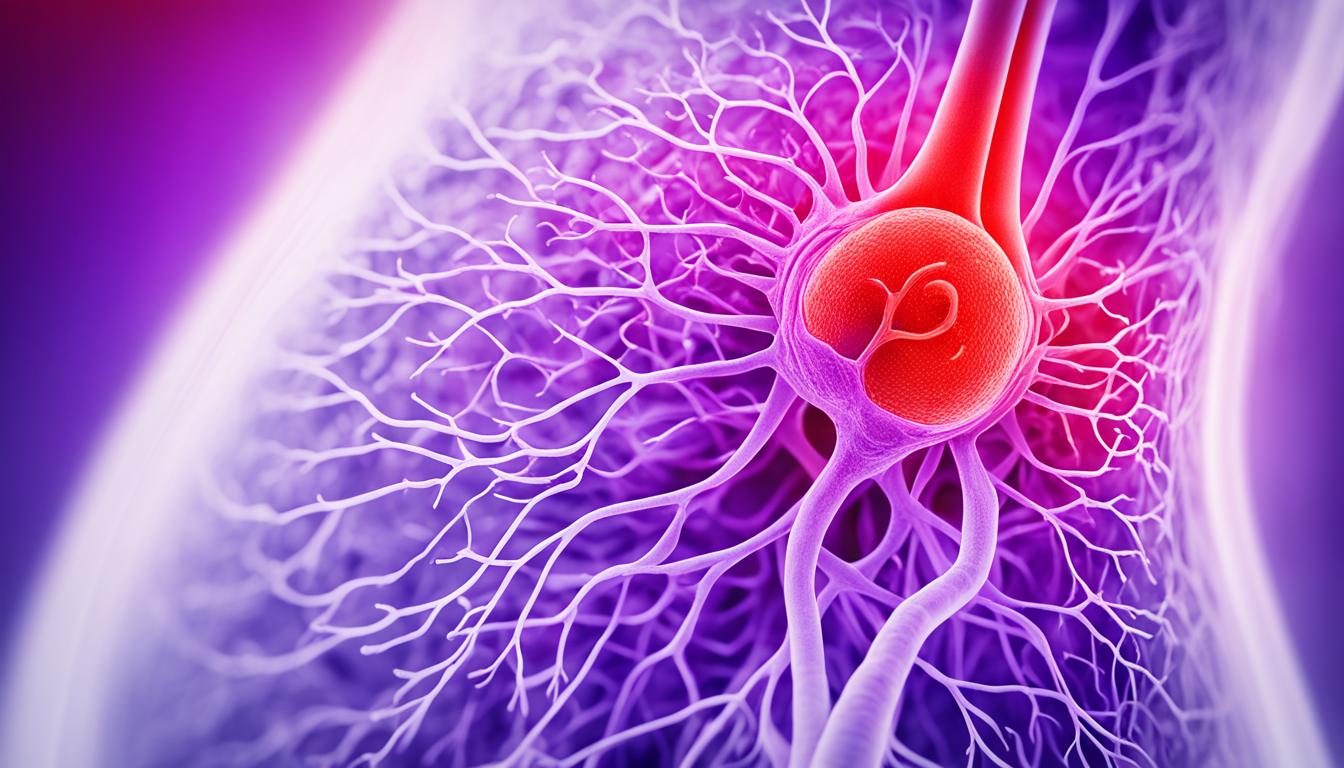Bladder exstrophy is an uncommon condition present at birth. It affects the urinary bladder and nearby parts. This issue happens because the abdominal wall doesn’t form right in the womb. This causes the bladder to be outside the body. It greatly impacts how the urinary system works and a person’s life.
The signs of bladder exstrophy include seeing the bladder outside the body and leaking urine. There are also issues with how the genital area looks. Scientists don’t yet know what exactly causes this. But they think it might be linked to both genes and the environment.
Doctors usually find bladder exstrophy in newborns during a check-up. They might also use special scans, like ultrasound or MRI. These help confirm the condition and understand it better.
The main way to treat bladder exstrophy is through surgery. This fixes the bladder and abdominal wall. After surgery, taking care of urinary health is key.
There’s now hope with stem cell therapy for treating bladder exstrophy. Early studies are positive about repairing bladder tissue with stem cells. This could lead to better health for those affected.
Key Takeaways:
- Bladder exstrophy is a rare congenital condition characterized by the failure of the abdominal wall to close properly during fetal development.
- Symptoms may include a visible bladder outside the body, urinary incontinence, and genital abnormalities.
- The exact cause of bladder exstrophy is unknown, but genetic and environmental factors are believed to play a role.
- Diagnosis is typically made shortly after birth through a physical examination and imaging tests.
- Treatment involves surgical repair and ongoing management of urinary function and continence.
- Stem cell therapy shows promise in bladder tissue regeneration for individuals with bladder exstrophy.
Historical Perspectives on Bladder Exstrophy
Bladder exstrophy is a rare condition that was first treated in 1788. Surgeons and medical experts have worked hard to improve care for patients with this condition. Their efforts over time have led to better surgery methods and care techniques.
In 1788, Andrew Bonn from Amsterdam invented an external bladder device. It was designed to protect and manage the bladder’s external drainage. This device was a big step forward for patients, making their lives more manageable.
Over the years, medical knowledge about bladder exstrophy grew. Doctors got better at repairing the bladder and the abdominal wall. This improved the lives of those with the condition, helping them to have a more normal urinary function.
Now, treating bladder exstrophy is a team effort. Urologists, pediatric surgeons, and other experts work together. They use what was learned in the past to give patients today the best care.
Advancements in Bladder Exstrophy Repair
Medical advancements have greatly improved how bladder exstrophy is treated. Now, surgeries are done in stages to rebuild the bladder and abdominal wall more effectively.
Table: Milestones in Bladder Exstrophy Treatment History
| Date | Milestone |
|---|---|
| 1788 | Andrew Bonn prescribes an external bladder device |
| 1891 | Jean Thiersch introduces the concept of rectus muscle closure |
| 1966 | Surgical technique using pubic symphysis fusion developed by Baden and Walker |
| 1986 | Modified Cantwell-Ransley procedure improves continence outcomes |
| 1997 | Modified Magpi technique introduced by Duckett to treat epispadias |
These milestones have greatly improved how bladder exstrophy is treated. They show how much progress has been made over time.
The story of bladder exstrophy is one of medical progress. From simple devices to complex surgeries, each development has helped patients live better lives.
Types and Associated Conditions
Bladder exstrophy is part of a group of birth defects known as the exstrophy-epispadias complex. It includes conditions like cloacal exstrophy and epispadias. Cloacal exstrophy is very severe, showing exposed bowel and bladder parts. In boys with bladder exstrophy, epispadias makes the urethra open on the penis’s top side. Bladder exstrophy might also be seen with conditions such as omphalocele and imperforate anus, which is called the OEIS complex.
| Type of bladder exstrophy | Description |
|---|---|
| Cloacal exstrophy | The most severe form of bladder exstrophy, characterized by a central field of exposed bowel flanked by two hemi-bladders. |
| Epispadias | Associated with bladder exstrophy in males, where the urethra is open on the dorsal side of the penis. |
| Combined exstrophy | Occurs in combination with other conditions like omphalocele (abdominal wall defect) and imperforate anus. |
Bladder exstrophy, cloacal exstrophy, and epispadias are all part of the larger exstrophy-epispadias complex. This includes a variety of birth defects affecting the urinary and reproductive systems. Each variant brings its own set of challenges and treatment needs. Knowing the differences and associated issues is key for the right diagnosis and management.

Cloacal Exstrophy
Cloacal exstrophy is the harsh extensive form of bladder exstrophy. Affected areas include the bowel and bladder, showing externally. This condition impacts multiple organs, including the bladder, intestines, and genitalia. Treatments usually involve surgery to rebuild the stomach wall, fix the organs, and make the urine and digestion systems work.
Epispadias
Epispadias happens in boys with bladder exstrophy, showing the urethra opening on the penis’s top side. This can make the penis short and curved. It could harm urinary function and sexual growth. Surgery corrects the urethra’s position and helps better bladder control.
Diagnosis and Management
Diagnosis of bladder exstrophy usually happens right after a baby is born. Doctors and nurses will check for a bladder that can be seen outside the body. They also look for urinary problems and genitalia abnormalities. To make sure of the diagnosis and understand the condition better, imaging tests like ultrasound and MRI are used. An ultrasound gives clear images of the bladder. An MRI helps the doctors plan surgery and understand the condition fully.
After finding out if someone has bladder exstrophy, a team of medical experts gets involved. This team includes urologists and pediatric surgeons. The main treatment is surgical repair, done in several stages. This surgery helps rebuild the bladder and the belly wall. It aims to control urine leakage and improve urinary functions.
Treating bladder exstrophy isn’t just about surgery. It includes several steps like:
- Bladder training: This teaches how to control the bladder better.
- Intermittent catheterization: Learning how to use a catheter helps keep the bladder empty.
- Possible future surgical interventions: More surgeries might be needed for better bladder control or capacity, based on what the patient needs.
A well-rounded treatment plan helps people with bladder exstrophy. It improves how the bladder works and makes life better.
| Diagnosis of Bladder Exstrophy | Imaging Tests for Bladder Exstrophy | Management of Bladder Exstrophy |
|---|---|---|
| – Physical examination after birth | – Ultrasound to assess the bladder and surrounding structures | – Surgical repair involving reconstructive procedures |
| – Assessment of visible bladder outside the body | – MRI for surgical planning and condition evaluation | – Multidisciplinary approach with urologists and pediatric surgeons |
| – Presence of urinary incontinence | – Confirming the diagnosis of bladder exstrophy | – Bladder training to improve continence |
| – Abnormalities in the genitalia | – Evaluating the extent of the condition | – Teaching intermittent catheterization techniques |
| – Possible future surgical interventions as needed |
Potential Advancements in Stem Cell Therapy
Stem cell therapy is emerging as a hopeful treatment for bladder exstrophy. This is a birth defect that affects the bladder. Stem cells could help fix and renew damaged bladder tissue. This could be a big step forward for people with this condition.
Animal studies show stem cells can improve bladder function and help tissue heal. This has made researchers and doctors hopeful. They think stem cell therapy could change how we treat bladder exstrophy.
But, we need more studies to make sure stem cell therapy is safe and works in people. Currently, research and trials are looking at different ways to use stem cells for this condition.
The progress in stem cell therapy for bladder exstrophy is exciting. It could lead to better treatments, better bladder performance, and a better life for those affected.
Current Research in Bladder Exstrophy Stem Cell Research
Scientists are looking into the healing abilities of stem cells for bladder exstrophy. They are focusing on:
- Identifying the best stem cell sources for repairing bladder tissue
- Improving how to transplant stem cells so they work well in the bladder
- Testing the safety and success of stem cell treatments over time in humans
- Understanding how stem cells can help the bladder work better and heal
This research is opening up new possibilities. It could lead to breakthroughs in healing and improve people’s lives with bladder exstrophy.
| Advantages of Stem Cell Therapy for Bladder Exstrophy | Challenges and Limitations |
|---|---|
| 1. Potential for bladder tissue regeneration | 1. Safety and efficacy in human trials |
| 2. Enhanced bladder function | 2. Identifying optimal sources of stem cells |
| 3. Improved treatment outcomes | 3. Successful engraftment and integration of stem cells |
| 4. Long-term durability of stem cell therapy |
The advances in research for bladder exstrophy are important. As our understanding grows, we hope these treatments will become reliable for patients.
Conclusion
Bladder exstrophy is a serious condition that babies can be born with. It needs a team of doctors to find it and decide on a treatment. Thanks to new ways of doing surgery, people with this condition now have better chances of living normal lives. And with ongoing studies into things like stem cell therapy, there’s hope for even more progress.
Treating bladder exstrophy is not easy, but a detailed plan helps a lot. This includes surgery, regular care, and maybe new treatments in the future. Doctors who know a lot about it, along with experts in new medical methods, work together. Their goal is to give patients the best results.
To sum up, knowing all about bladder exstrophy is key for doctors who help those affected by it. By keeping up with new research, medical professionals can provide top-notch care. They help patients deal with bladder exstrophy throughout their lives.

